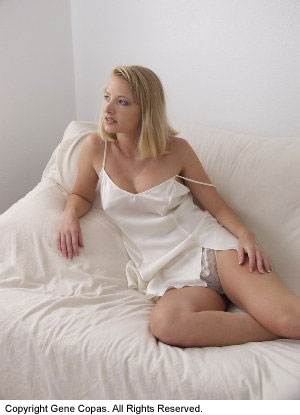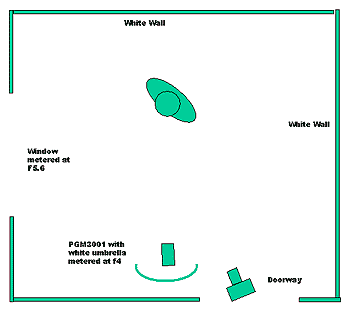 During a recent trip to Phoenix, I had the pleasure of meeting and working with the talented model and photographer, Cassandra Campbell. This beautiful young lady is an absolute delight to work with. And, for the traveling photographer, she offers a real bonus: she has her own studio.
During a recent trip to Phoenix, I had the pleasure of meeting and working with the talented model and photographer, Cassandra Campbell. This beautiful young lady is an absolute delight to work with. And, for the traveling photographer, she offers a real bonus: she has her own studio.
One of the first outfits we chose to work with was some white lingerie. I decided to go with a classical high key type of look. When shooting high key, the idea is to keep your fill light (shadows) about one stop less than the key light (highlights).
Cassandra’s studio is in a two story condo unit and we decided to shoot this photo in one of the upstairs bedrooms. The room has a good size window along one wall and it was providing a good amount of diffused light from outside. I would not have shot this if the light coming in were direct sunlight. That would have given me too much contrast to make the shot work.
What I was looking for was a soft, pensive look. Where the subject’s thoughts are “way out there” someplace, and totally unaware that they are being watched, much less being photographed.
I metered the light from the window and the incident light reading was f/5.6 at 30th of a second for ISO 80/100. I considered using on-camera fill flash, as the room was rather small, but I thought that might give me too harsh shadows. I wanted a very soft look and didn’t want a noticeable shadow on the background or on Cassandra.
I was using an Olympus E-10, which has a very small built in flash with pretty strong light output. In order for light to be “soft”, it must be a large light source at a very close distance. If you consider why there are distinct shadows on a sunny day, keep in mind that the sun is a very large light source, but it is a long way off. On a cloudy, overcast day, the clouds are illuminated by the sun and the clouds become a very large light source that is very close – in relative terms.
The Olympus has a flash that measures ¼” x 1 ¼”. Which in anyone’s definition would make it a very small light source. At a distance of about six feet from the model it would give rather hard shadows. So, that was not going to work for the feeling that I wanted to establish.
Instead of on-camera fill, I decided to use a Photographers Warehouse PGM-3001 monolight with a 30” white umbrella. This was placed inside the room, approximately five feet from Cassandra. It was set on low power and metered for f/4 for fill. One stop less than the window light.
If my fill light had been set too high, I would have lost all of the texture in the white garments and the white throw cover on the sofa.
A little observation about shooting with digital cameras. This comes from personal experience, but I have found that the digital cameras do not handle contrasty lighting as well as they handle flatter lighting. And, folks, please don’t always believe the image on the little LCD panel on the back of the camera. When you download the images to your computer or print them, they may not look anything like what you saw on that little LCD.
Experiment and find out what works with your particular camera and printer, then establish settings that work for you. It is the same as changing film types in your film based camera, a process that can be somewhat unpredictable.
Most digital cameras are derived from video cameras, and have not been designed by people who are familiar with still photography. These cameras do have their idiosyncrasies. So, experiment and learn and enjoy the new adventure.
Cassandra can be reached at cassi_campbell@hotmail.com .

by Gene Copas

Leave a Reply